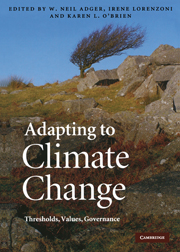Book contents
1 - Adaptation now
Published online by Cambridge University Press: 31 August 2009
Summary
Introduction
Look out the window and assess the weather. If it is hot, change into a lighter shirt. If it is raining, take an umbrella. This is adaptation to changing weather.
Adaptation to changing climate is a different matter. The climate may change either slowly or rapidly, and the changes may be irreversible and impossible to predict with any accuracy. The simple principles of adapting to changing weather begin to break down when the climate changes. In the context of climate change the options for adaptation may involve relocating homes, moving cities, changing the foods we grow and consume, seeking compensation for economic damages, and mourning the loss of our favourite place or iconic species. The difference between adapting to changing weather and adapting to a changing climate lies both in the time-frame and in the significance of the changes required. Moreover, the consequences of not adapting to climate change may be far more serious than not adapting to changing weather.
There are two aspects of climate change that have profound significance for adaptation. First is the growing recognition that the weather is no longer ‘natural’. While the weather varies and changes seasonally as part of the natural rhythm of our lives, climate change, as it is presently observed, is now beyond all reasonable doubt driven by human activities. This induces a feeling, for some, that the world is sullied, and nature itself is at an end (McKibben, 1999).
- Type
- Chapter
- Information
- Adapting to Climate ChangeThresholds, Values, Governance, pp. 1 - 22Publisher: Cambridge University PressPrint publication year: 2009
References
- 20
- Cited by

